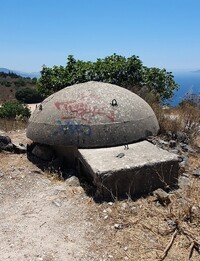Photo. A bunker in Sarande, Albania - one of the small dome-shaped concrete shelters that were rose across the country. From Cold War Relics to Cultural Icons - no foreign army ever crossed Albania’s borders, but the bunkers stayed. © Travel Explorations.
During my journey in Albania in July 2025, I explored the mushroom bunker mystery. My fascination was strong for the strange, often mushroom-shaped constructions from the Communist times. What is this? And why was it built?
The mystery of abandoned cold war bunkers leaded me both high and low - these “survival bunkers” have secured survival in the history, and finally I got the chance to take a more thoroughly look at them.
The first day I explored the bunkes around Lekursi Castle in Sarande. This former castle is located on hilltop - now a restaurant, where you can get wonderful views over the city of Saranda and Butrint lagoon, especially at sunset. My guide told me that it was a tunnel between one of the bunkers and the castle.
Another day I explored the strange construction called Memorje '78. It's another concrete bunker from the Communist times, located in the centre of Saranda in Albania.
Some other mushroom shaped bunkers in the country are well hidden, limited available in hillsides, or risky to enter due to hidden mines or explosives. In Albania there are a large number of concrete bunkers, with estimates ranging from 173,371 to over 750,000.
These bunkers were built during the communist era under Enver Hoxha, primarily from the 1960s to the 1980s. The high number of bunkers reflects a policy of "bunkerization" aimed at defending the country against potential invaders.
Through history there are several examples of “mad undertakings” by dictators. Some of these are:
- The emperor Caligula in Rome built floating palaces (party ships) on Lake Nemi, complete with marble floors, fountains, and heated baths - not for war, but wild parties. He strung ships into a bridge across the sea, just to ride his horse over water. In Rome, golden statues of himself were dressed daily in his clothes, while temples rose in his own honor. Madness became architecture (reign: 37–41 AD: he was 24 year when he became emperor).
- The president Ceaușescu flattened Bucharest to crown his concrete palace - the world largest building (28 March 1974 – 22 December 1989).
- Kim Jong-il built fake villages to impress the world - with empty streets and staged facades (2018).
- Chancellor of Germany Adolf Hitler dreamed up a super-capital of towering stone that war buried before it rose. He wanted to design a new capital, “Welthauptstadt Germania,” with colossal buildings. It began in the late 1930s, with planning and construction efforts underway from around 1937 to 1943.
- Saddam in Iraq tried to resurrect Babylon with temples, theaters, and even a cable car “Archaeological Restoration of Babylon Project” (1978).
- The Shah in Iran toasted 2,500 years of empire with golden tents and global guests in Persepolis. In 1971, he threw one of history’s most extravagant parties - a feast for 2,500 years of empire.
- Prime Minister Nikola Gruevski, who led the country from 2006 to 2016, reshaped the Macedonia’s capital Skopje into a surreal stage of oversized statues, faux-classical buildings, and fountains lit like Vegas.
These tell that history is full of wild dreams turned concrete by dictators. There was one in Albania too. Enver Hoxha was the communist dictator of Albania who ruled the country with absolute power from 1944 until his death in 1985. He established one of the most repressive and isolationist regimes in the world during the Cold War. Under Hoxha, Albania became one of the most closed-off countries on the planet. Foreign influence was seen as a threat and contact with the outside world was extremely limited.
One of Hoxha`s most notorious policies was the mass construction of concrete bunkers all over the country - around 170,000 of them. These were built under the regime of Enver Hoxha between the 1960s and 1980s as part of his extreme defense strategy. The density is staggering - roughly 5.7 bunkers per square kilometres, or about one bunker for every 11 people at the time of construction (source: Bunkers in Albania on Wikipedia). He was obsessed with the idea of invasion and wanted Albania to be always prepared for war. Hoxha was really worried that the country could be attacked by NATO, the Soviet Union, even neighboring Yugoslavia or Greece. Despite no real threat, he prepared also the country for a total war that never came. Each was meant to house a single soldier or a small unit, ready to fight to the death.
The scale was absurd. Bunkers were placed in forests, on beaches, mountains, besides schools, in cemeteries - even in vineyards and along hiking trails. Many were barely usable, and most were never used at all. But that madness also left a legacy unlike any other in the world. What was once a symbol of fear has become an unlikely symbol of Albania’s uniqueness - something you can observe, touch, walk into, and reflect inside.
His regime was marked by strict censorship, political purges, secret police, and labour camps. Thousands were imprisoned or executed as “enemies of the state.” Despite the brutality, Hoxha maintained control through fear and propaganda, leaving behind a legacy that still shapes Albania's landscape and memory today.
Today, these ghostly sentinels of the Cold War stand not as symbols of war, but as markers of resilience, transformation, and even creativity. Some serve as humble animal shelters or storage sheds. Others have been reborn as cafes and art galleries. restaurants serving traditional food and wine, curiously unique settings for guesthouses, art and history museums, and even tattoo studios. People in Albania have suffered for a long time both in the communist era and afterwars – now they reach out their hands outside the borders and reconnect with rest of the world. It takes time, but the hope is there.
What began as a monument to isolation has become part of Albania’s evolving identity - a strange, stubborn beauty etched into the landscape. The bunkers, once born of paranoia, now echo with new purpose. Albania’s bunkers, once born of fear, now echo with creativity and reinvention.
Stein Morten Lund, July 2025
Additional information
Read more about bunkers in Albania on Wikipedia:
Hoxha's program of "bunkerization" (bunkerizimi) resulted in the construction of bunkers in every corner of the then-People's Socialist Republic of Albania, ranging from mountain passes to city streets.












